Abstract
A procedure for enumerating and identifying Vibrio vulnificus in oysters was developed and evaluated. This method consists of growth on a direct plating medium (VVE medium) for isolating the organism from shellfish tissues, followed by biochemical tests for differentiating and identifying presumptively positive isolates. Densities of V. vulnificus are reliably obtained in 2 to 4 days, and as few as 10 culturable cells per 100 g can be identified. The procedure was evaluated by using a DNA probe technique specific for the cytotoxin-hemolysin gene of V. vulnificus and gas chromatographic analysis of the fatty acid contents of positive isolates. Only 3.2 and 0.4% of the isolates gave false-positive and false-negative results, respectively. The average level of recovery on VVE medium for 33 strains, including both clinical and environmental isolates, was 92% of the level of recovery obtained with brain heart infusion agar supplemented with 1% NaCl. The densities of V. vulnificus in oyster homogenates and individual oysters harvested from gulf and Atlantic coastal waters revealed that seasonally high levels occurred. The VVE medium procedure facilitated enumeration of this pathogen in molluscan shellfish and had a distinct advantage over the widely used most-probable-number procedure for V. vulnificus enumeration, which requires 5 to 7 days and often gives improbable and imprecise results.
Full text
PDF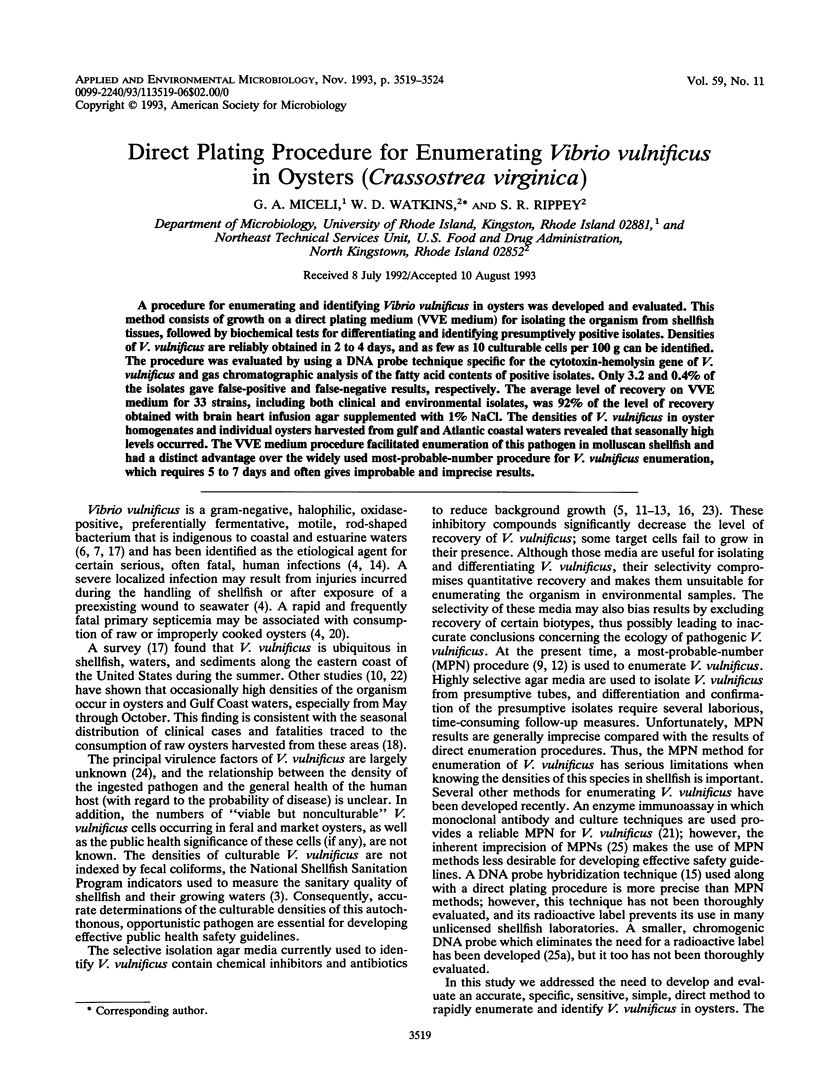
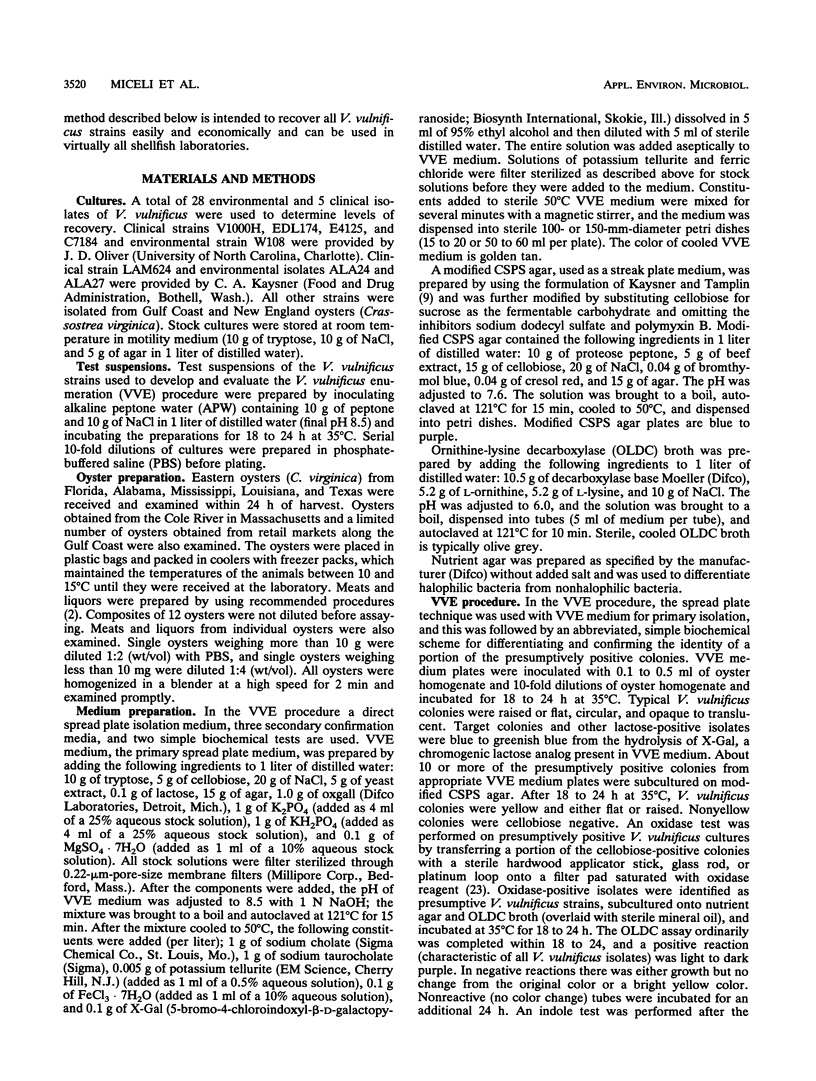
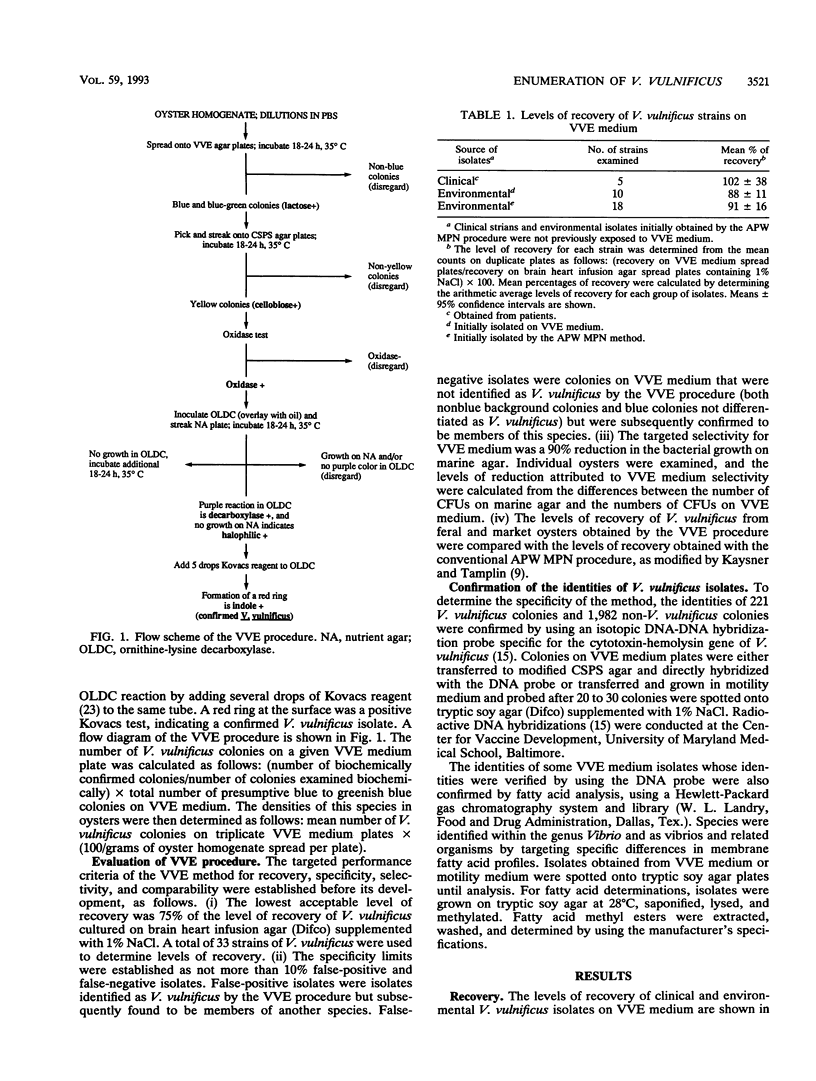
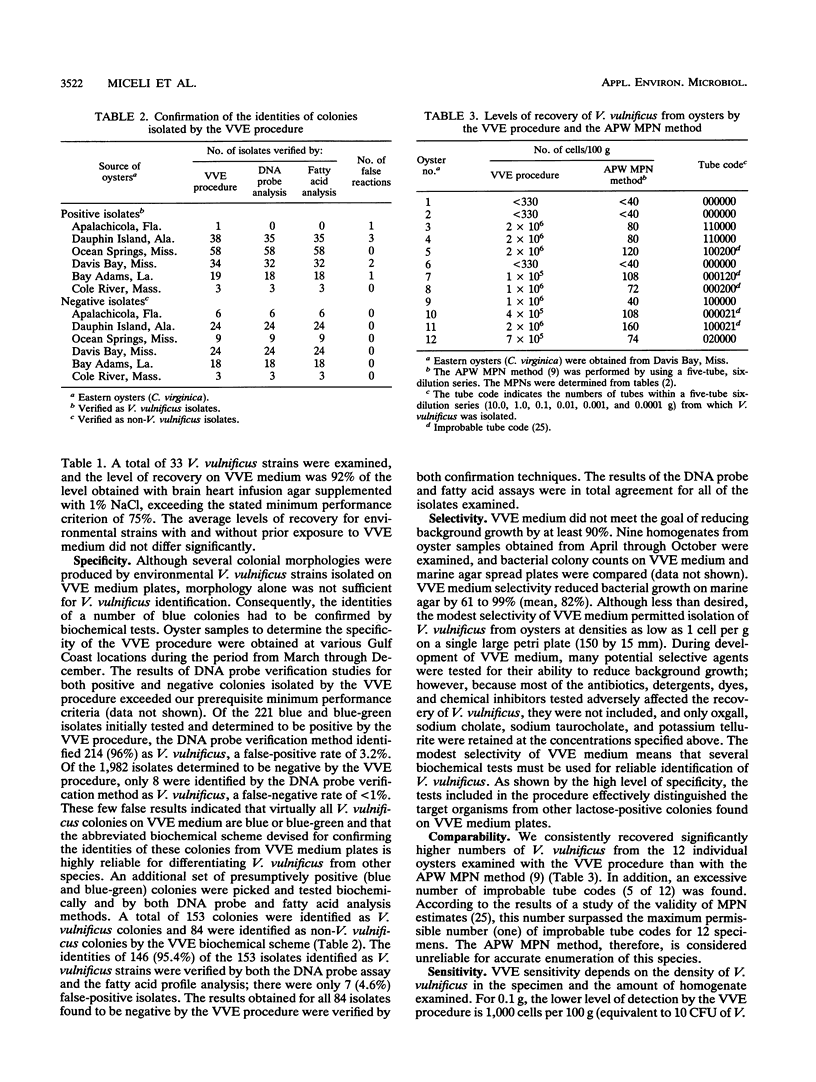
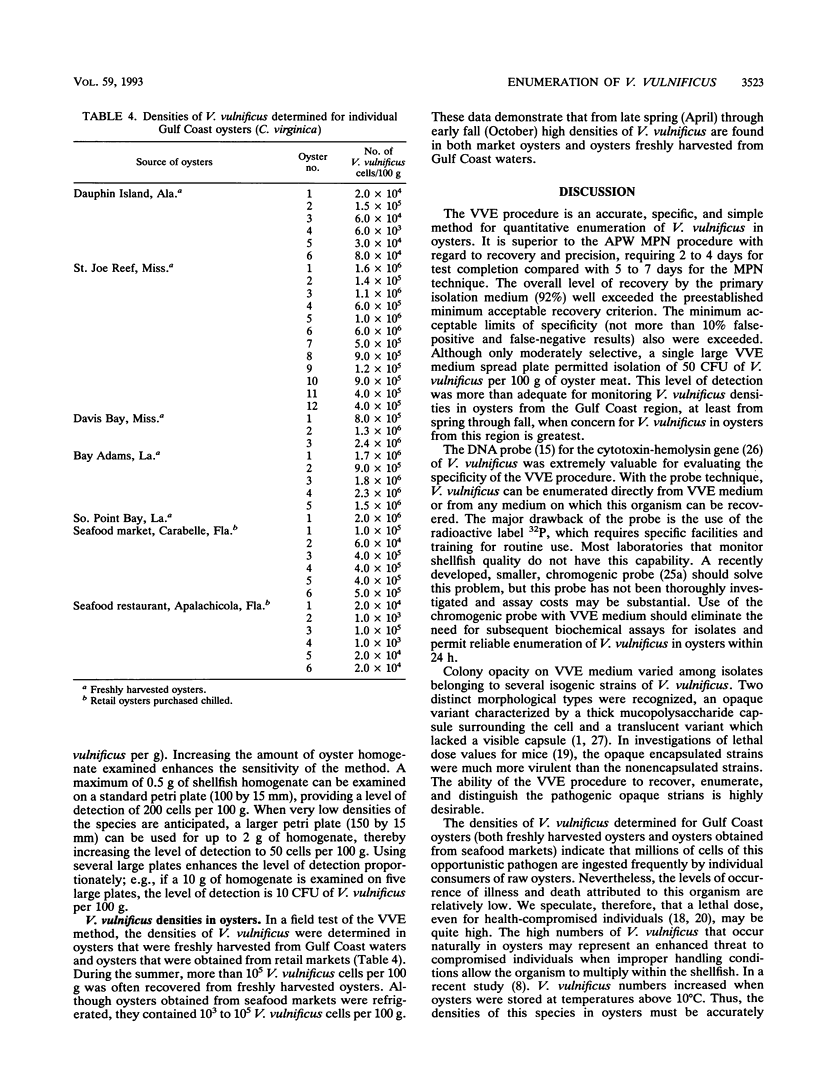
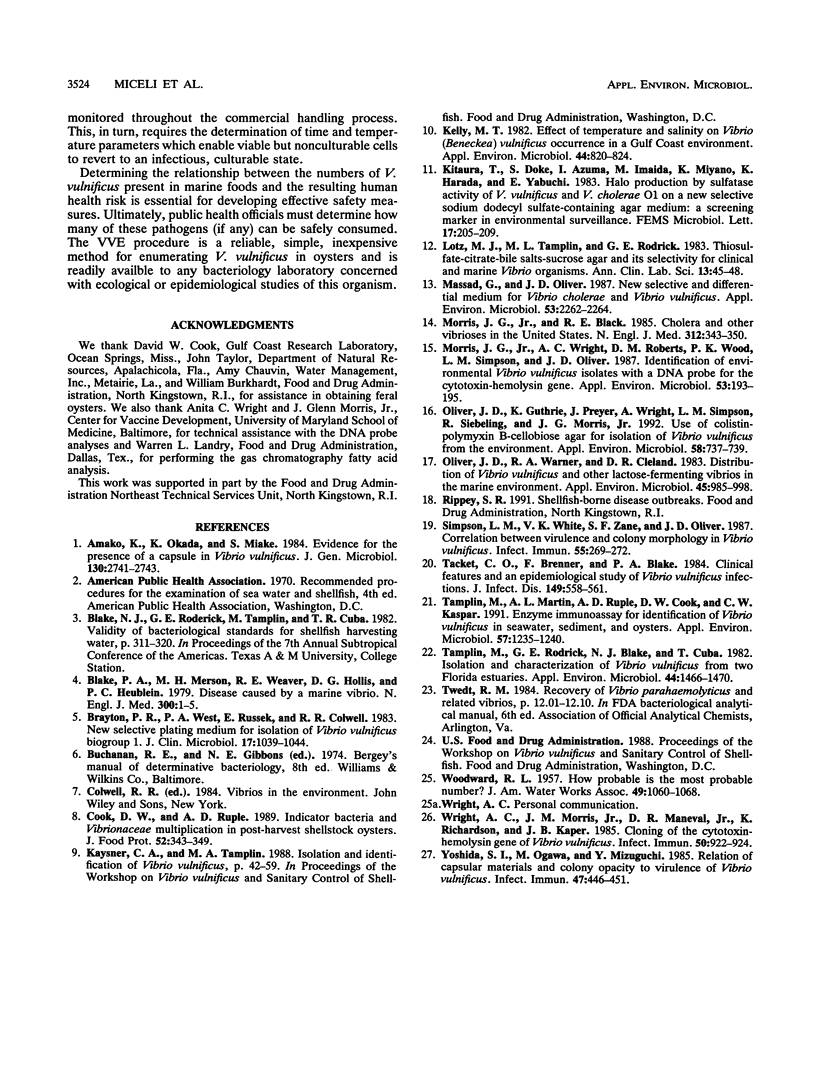
Selected References
These references are in PubMed. This may not be the complete list of references from this article.
- Amako K., Okada K., Miake S. Evidence for the presence of a capsule in Vibrio vulnificus. J Gen Microbiol. 1984 Oct;130(10):2741–2743. doi: 10.1099/00221287-130-10-2741. [DOI] [PubMed] [Google Scholar]
- Blake P. A., Merson M. H., Weaver R. E., Hollis D. G., Heublein P. C. Disease caused by a marine Vibrio. Clinical characteristics and epidemiology. N Engl J Med. 1979 Jan 4;300(1):1–5. doi: 10.1056/NEJM197901043000101. [DOI] [PubMed] [Google Scholar]
- Brayton P. R., West P. A., Russek E., Colwell R. R. New selective plating medium for isolation of Vibrio vulnificus biogroup 1. J Clin Microbiol. 1983 Jun;17(6):1039–1044. doi: 10.1128/jcm.17.6.1039-1044.1983. [DOI] [PMC free article] [PubMed] [Google Scholar]
- Kelly M. T. Effect of temperature and salinity on Vibrio (Beneckea) vulnificus occurrence in a Gulf Coast environment. Appl Environ Microbiol. 1982 Oct;44(4):820–824. doi: 10.1128/aem.44.4.820-824.1982. [DOI] [PMC free article] [PubMed] [Google Scholar]
- Lotz M. J., Tamplin M. L., Rodrick G. E. Thiosulfate-citrate-bile salts-sucrose agar and its selectivity for clinical and marine vibrio organisms. Ann Clin Lab Sci. 1983 Jan-Feb;13(1):45–48. [PubMed] [Google Scholar]
- Massad G., Oliver J. D. New selective and differential medium for Vibrio cholerae and Vibrio vulnificus. Appl Environ Microbiol. 1987 Sep;53(9):2262–2264. doi: 10.1128/aem.53.9.2262-2264.1987. [DOI] [PMC free article] [PubMed] [Google Scholar]
- Morris J. G., Jr, Black R. E. Cholera and other vibrioses in the United States. N Engl J Med. 1985 Feb 7;312(6):343–350. doi: 10.1056/NEJM198502073120604. [DOI] [PubMed] [Google Scholar]
- Morris J. G., Jr, Wright A. C., Roberts D. M., Wood P. K., Simpson L. M., Oliver J. D. Identification of environmental Vibrio vulnificus isolates with a DNA probe for the cytotoxin-hemolysin gene. Appl Environ Microbiol. 1987 Jan;53(1):193–195. doi: 10.1128/aem.53.1.193-195.1987. [DOI] [PMC free article] [PubMed] [Google Scholar]
- Oliver J. D., Guthrie K., Preyer J., Wright A., Simpson L. M., Siebeling R., Morris J. G., Jr Use of colistin-polymyxin B-cellobiose agar for isolation of Vibrio vulnificus from the environment. Appl Environ Microbiol. 1992 Feb;58(2):737–739. doi: 10.1128/aem.58.2.737-739.1992. [DOI] [PMC free article] [PubMed] [Google Scholar]
- Oliver J. D., Warner R. A., Cleland D. R. Distribution of Vibrio vulnificus and other lactose-fermenting vibrios in the marine environment. Appl Environ Microbiol. 1983 Mar;45(3):985–998. doi: 10.1128/aem.45.3.985-998.1983. [DOI] [PMC free article] [PubMed] [Google Scholar]
- Simpson L. M., White V. K., Zane S. F., Oliver J. D. Correlation between virulence and colony morphology in Vibrio vulnificus. Infect Immun. 1987 Jan;55(1):269–272. doi: 10.1128/iai.55.1.269-272.1987. [DOI] [PMC free article] [PubMed] [Google Scholar]
- Tacket C. O., Brenner F., Blake P. A. Clinical features and an epidemiological study of Vibrio vulnificus infections. J Infect Dis. 1984 Apr;149(4):558–561. doi: 10.1093/infdis/149.4.558. [DOI] [PubMed] [Google Scholar]
- Tamplin M. L., Martin A. L., Ruple A. D., Cook D. W., Kaspar C. W. Enzyme immunoassay for identification of Vibrio vulnificus in seawater, sediment, and oysters. Appl Environ Microbiol. 1991 Apr;57(4):1235–1240. doi: 10.1128/aem.57.4.1235-1240.1991. [DOI] [PMC free article] [PubMed] [Google Scholar]
- Tamplin M., Rodrick G. E., Blake N. J., Cuba T. Isolation and characterization of Vibrio vulnificus from two Florida estuaries. Appl Environ Microbiol. 1982 Dec;44(6):1466–1470. doi: 10.1128/aem.44.6.1466-1470.1982. [DOI] [PMC free article] [PubMed] [Google Scholar]
- Wright A. C., Morris J. G., Jr, Maneval D. R., Jr, Richardson K., Kaper J. B. Cloning of the cytotoxin-hemolysin gene of Vibrio vulnificus. Infect Immun. 1985 Dec;50(3):922–924. doi: 10.1128/iai.50.3.922-924.1985. [DOI] [PMC free article] [PubMed] [Google Scholar]
- Yoshida S., Ogawa M., Mizuguchi Y. Relation of capsular materials and colony opacity to virulence of Vibrio vulnificus. Infect Immun. 1985 Feb;47(2):446–451. doi: 10.1128/iai.47.2.446-451.1985. [DOI] [PMC free article] [PubMed] [Google Scholar]


